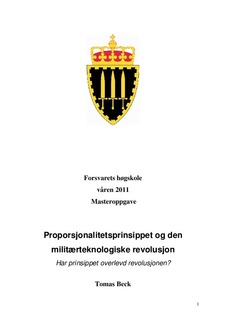Proporsjonalitetsprinsippet og den militærteknologiske revolusjon: har prinisippet overlevd revolusjonen?
Master thesis
Permanent lenke
http://hdl.handle.net/11250/99994Utgivelsesdato
2011Metadata
Vis full innførselSamlinger
- Masteroppgaver [450]
Sammendrag
Proportionality is an essential principle of the Law of Armed Conflict (LOAC). This principle acknowledges that incidental harm to civilians and civilian objects inevitably occurs in war. According to the proportionality rule, the expected collateral damage from an attack on a lawful target must not be excessive in relation to the concrete and direct military advantage anticipated. That is easily stated, but what implications it has on a high-tech actor on today’s battlefield is more complex. This paper considers the current law regarding proportionality and what implications technology has on those making targeting decisions. It has not been possible to identify clear guidelines on the practical application, but one conclusion is the standard of the “reasonable military commander”. Officers are thus expected to make decisions in accordance with what would be expected of an officer of the same age, rank, experience and education. It is also evident that the standards for compliance with the precautions in attack rules are higher for those that have access to the latest technology. The law does not require states to acquire such technology, but once they are fielded they should be used when available, and there is a risk of civilian harm. The paper then goes on to examine how technology has affected the principle itself. Although new technologies certainly can provide less collateral damage it has also increased the number of targets that can be attacked, which makes compliance more difficult. At the same time, officers are seeing traditional excuses for causing collateral damage being removed, and decisions made available for scrutiny, which in turn increase the willingness to comply with the principle.
